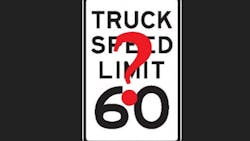DOT announces speed limiter proposal; mph setting open for debate
While the 118-page proposal suggests that speed limits of 60, 65 or 68 mph would be beneficial, the agencies will get public input before setting the actual number, according to U.S. Transportation Sec. Anthony Foxx. The speed limit would be a physical one accomplished by a speed-governing device and would apply to all newly-manufactured vehicles with a gross vehicle weight rating more than 26,000 lbs. (11,793.4 kg).
The rule comes from both NHTSA and FMCSA to broaden its applicability. According to the proposed rule, NHTSA would require speed limiters for multipurpose passenger vehicles, trucks, buses and school buses, while FMCSA would require them for commercial motor vehicles.
"Based on the agencies' review of the available data, limiting the speed of these heavy vehicles would reduce the severity of crashes involving these vehicles and reduce the resulting fatalities and injuries. We expect that, as a result of this joint rulemaking, virtually all of these vehicles would be limited to that speed," the proposal reads, with "that speed" yet to be determined.
Speed limiters: DOT's math for 60, 65, 68 mph
In a release, Foxx argues that the proposed rule would save lives and more than $1 billion in fuel costs annually, making it "a win for safety, energy conservation and our environment." Foxx has referred to this rulemaking as a top priority for the Department of Transportation, and the proposed rule originally was due to be published in March 2014; the idea behind it dates back nearly a decade.
NHTSA Administrator Mark Rosekind calls the proposal "basic physics" in the same release. "Even small increases in speed have large effects on the force of impact," he states. "Setting the speed limit on heavy vehicles makes sense for safety and the environment." And FMCSA Administrator Scott Darling contends that the proposal "will save lives while ensuring our nation's fleet of large commercial vehicles operates efficiently."
The proposed rule has been submitted for publication in the Federal Register, and once that happens there will be a 60-day period for public comment.
In 2006, American Trucking Assns. adopted a policy in favor of limiting the maximum speed of new trucks to 68 miles per hour. Later that year, the Association petitioned FMCSA and NHTSA to issue a regulation requiring their use. In 2008, as part of ATA’s 18-point highway safety agenda, the federation endorsed a national speed limit of 65 mph for all vehicles.
“As an industry, we cannot be afraid of technology, but we also must make sure that technology has proven benefits,” said ATA President and CEO Chris Spear. “Carriers who already voluntarily use speed limiters have found significant safety, as well as fuel efficiency and equipment lifespan benefits with little to no negative impact on productivity. We will be carefully reviewing and commenting upon today’s proposal.”
Road Safe America, a highway safety advocacy group, also petitioned for the speed limiter mandate. Following the DOT announcement Friday, RSA’s website called on supporters to contact Congress to demand that the mandate all trucks with governors—not just newly built models—must set them according to the final rule.
One group that's sure to have something to say will be the Owner-Operator Independent Drivers Association (OOIDA), which has long been opposed to truck speed limiters and makes almost a polar opposite argument regarding the devices as the government does. On the heels of the proposed rule's release, OOIDA issued a statement calling it "dangerous" not only for truck drivers but for passenger vehicle drivers as well.
"The government's proposal to mandate speed limiting devices on large trucks would be dangerous for all highway users," OOIDA states. "Such devices create speed differentials that lead to more crashes and promote road rage among other motorists."
Todd Spencer, executive vice president of OOIDA, further states that "highways are safest when all vehicles travel at the same relative speed."

